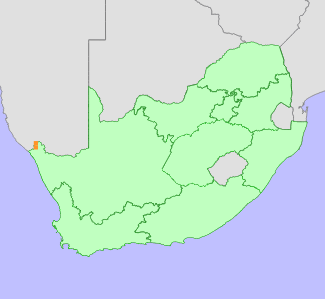|
Scientific Name | Psammophora saxicola H.E.K.Hartmann |
Higher Classification | Dicotyledons |
Family | AIZOACEAE |
National Status |
Status and Criteria | Endangered A4ace |
Assessment Date | 2022/08/03 |
Assessor(s) | P.C.V. Van Wyk, N.A. Helme & D. Raimondo |
Justification | A restricted range endemic to the Richtersveld region of South Africa. The population is currently declining rapidly as a result of loss of habitat to mining and mortality due to drought. An overall decline of between 50 and 75% is suspected over a shifting time window between 1980 and 2045 (generation length 25 years). This species therefore qualifies for listing as Endangered under criterion A. This species also occurs on the Namibian side of the Orange river however the population is experiencing similar pressure from mining and mortality from drought, there is therefore no adjustment of its regional status. |
Distribution |
Endemism | Not endemic to South Africa |
Provincial distribution | Northern Cape |
Range | This species is found in the Gariep Valley in the Northern Cape Province of South Arica, Richtersveld region and the Spergebeit region of southern Namibia. |
Habitat and Ecology |
Major system | Terrestrial |
Major habitats | Desert |
Description | It grows on stony, shaley, south facing slopes. |
Threats |
| All subpopulations in South Africa fall within the Lower Orange River mining licensed area and there is ongoing loss of habitat, and subpopulations as a result of mining activities. There is also mining activity happening within its range in Namibia. The population is also declining due to climate change. Its entire range has experienced below-average rainfall since 2012. Predictions of future climate change include further increases in annual average temperature of between 1.4°C and 2.4°C by 2050, which will result in unbearably hot temperatures and ongoing aridification throughout significant portions of the year (Van Wilgen et al. 2017). |
Population |
The population is currently declining. Approximately 20% of the South Africa portion of the population has been lost from past mining and another 20% can be expected to be lost over next 10 years. Monitoring of stands of individuals all across the South African side of the population in 2021 quantified that 80-90% of plants had died as a result of the worst drought on record that started in 2012, intensified between 2015 and 2020 and is still ongoing at the time of assessment. Fortunately this species has extensive seed banks and can germinate rapidly in response to rainfall. There has already been some effective recruitment noted in the western portion of its range from rainfall that occurred in 2020, however follow up rains will be important to ensure that the species can persist. Given ongoing aridification predications and the fact that the population is likely to be experiencing similar levels of drought related declines in Namibia an overall decline of between 50 and 75% is suspected to take place over a shifting time period starting in 1980 and ending in 2045 (generation length 25 years).
|
Population trend | Decreasing |
Bibliography |
Snijman, D.A. 2013. Plants of the Greater Cape Floristic Region 2: The extra Cape flora. Strelitzia 30. South African National Biodiversity Institute, Pretoria.
Van Wilgen, N.J. and Herbst, M. 2017. Taking stock of parks in a changing world: The SANParks Global Environmental Change Assessment. SANParks, Cape Town.
|
Citation |
| Van Wyk, P.C.V., Helme, N.A. & Raimondo, D. 2022. Psammophora saxicola H.E.K.Hartmann. National Assessment: Red List of South African Plants version 2024.1. Accessed on 2025/11/11 |
 Comment on this assessment
Comment on this assessment

